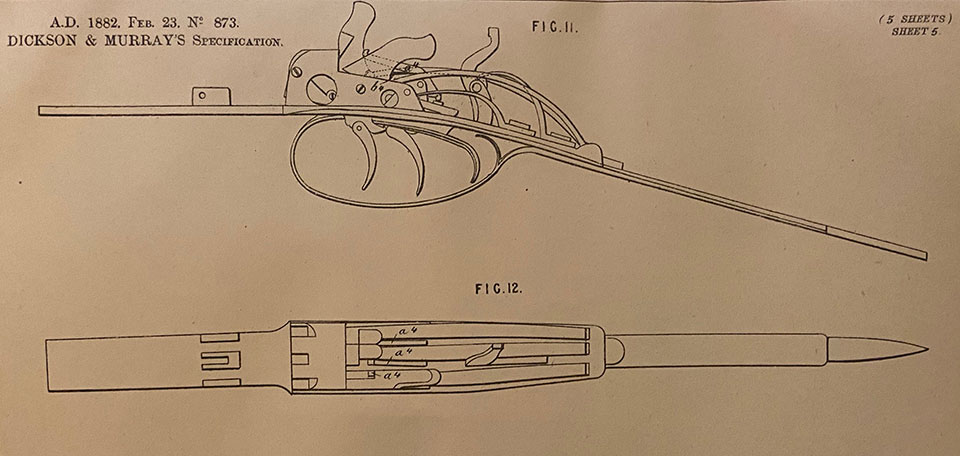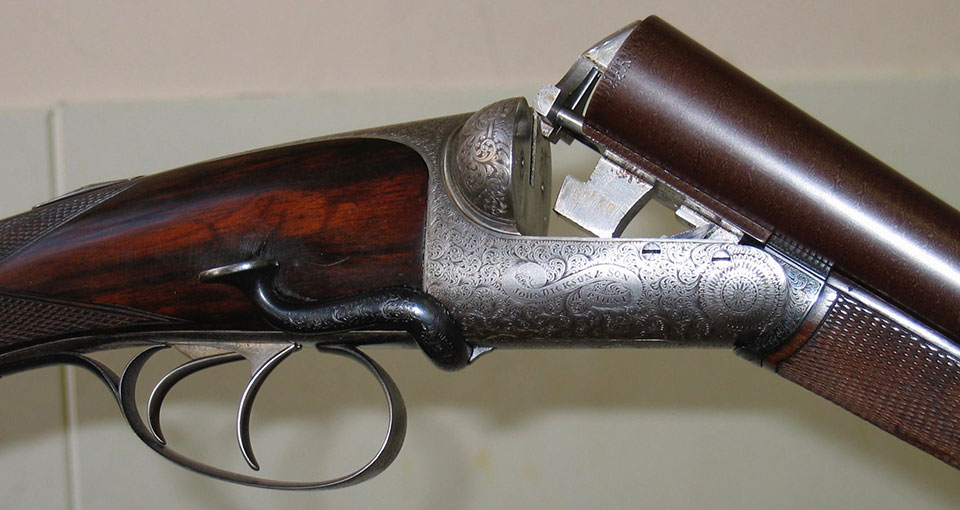British gun-making was at its peak in the years before the First World War. Leading up to 1911, there had been sixty years of unbridled breech-loader development, during which the sporting gun moved from pin-fire to centre-fire, from flimsy, or slow operating, platforms to gracefully efficient, interlinked mechanisms which cocked, fired and ejected with ease and speed. The Edwardian gentleman really did have it all in terms of sporting gunnery.
The early twentieth century ‘best’ gun was a sublime manifestation of the gunmaker’s vision, crafted into aesthetic and operational perfection. Gunmakers, then, were at the top of their game and the product would never be bettered. The prominent firms of the day built significant fortunes, based on novel designs, gun-making skills and hard-nosed business acumen.
The conventional wisdom had it that London guns were superior products, though Birmingham produced far more numbers and quietly furnished many a London name with the hardware on which it built its reputation.

By the late nineteenth century, two major designs dominated the trade. One was the bar-action, side-lock and the other, the Anson & Deeley boxlock. The classic ‘London pattern’ side-lock ejector, was a ‘best’ gun, stocked to the fences, with bar-action locks and a distinctly graceful profile. The two most recognisable forms were the Purdey (Beesley) and the Holland & Holland ‘Royal’. The Boss lost its shouldered action and, by 1900, the three guns looked very similar, though mechanics, internally, were quite different.
The boxlock, originating with Westley Richards in Birmingham, though more often produced as a ’best’ gun than most people realise, found its place as the staple of middle-grade guns. The boxlock proved very reliable and was cheaper to produce than a side-lock in each grade. So, you sold a better gun for a middling budget if you made a boxlock.
At the same time Frederick Beesley was putting the final touches to his iconic, spring-cocking, side-lock patent for Purdey, a very different idea was to develop into a distinct branch of ‘best’ gun, with a very Scottish character. This would create a third option for the discerning sportsman. That gun was the ‘round action’ and the principle exponent of the type was John Dickson.
John Dickson
The founder of Scotland’s most famous gun-maker followed a route into business ownership common to most of his contemporaries. Dickson apprenticed with a very good local gunmaker, saved his money, perfected his craft and made his plans. He first opened a shop on his own account, at 60 Princes Street, Edinburgh, in 1838, having left his master, James Wallace, that year.
Like many a Victorian gun-maker, John Dickson was succeeded by his son and his grandson, all called John Dickson. They ran the company, in turn, from its creation, by the forty-four-year-old founder, to its sale, in 1923, by his eighty-year-old grandson . The family carried the company through the best years of the British gun trade and relinquished control just before it went into steep decline. Co-incidence or canny Scots? We can but speculate.
Dickson’s Guns & Rifles
John Dickson was not just a retailer of fine guns, but an innovator. In the 1840s he built two-groove percussion rifles that pre-date Purdey’s famous ‘express’ rifles and achieved great success with their flat-shooting, long-range accuracy. He sold rifles equipped with a telescopic sight as early as 1850 and was quick to adopt breech-loaders, building his first in 1858.
By 1860 Dickson’s breech-loaders were out-selling his percussion guns and he was quick to adopt choke-boring, selling his first choked gun in 1875, just months after the ground-breaking Field trials had determined the effectiveness of the concept.

During the mid nineteenth century, Dickson built centre-fire hammer guns on the actions adopted by most of his contemporaries. Lancaster’s ‘slide-and-drop’ action, was strong, graceful and popular, Dickson also built guns with the Westley Richards bolted doll’s-head, the Jones screw-grip, the Purdey bolt and the Grant & Hodges action. He even used Horsley’s sliding top-lever on one occasion. As well as shotguns and double rifles, Dickson sold falling-block rifles of several types, including the Henry patent of 1865.
However, in 1880, Dickson offered the sporting public the design for which he would became famous. His patent was a trigger-plate gun, which came to be known as the round-action.
The Round Action
The first Scottish trigger-plate gun was patented by Dickson’s neighbour, James MacNaughton, in July 1879. The second, by John Dickson, was filed in January 1880. Although both are similar actions, using long, bow-shaped mainsprings, mounted on a wide trigger-plate, there are significant mechanical differences between the two guns.
MacNaughton’s ‘Edinburgh Gun’ was conceived as a lever-cocking system but eventually evolved into a barrel-cocker, like the Dickson. In its classic form, it is a ‘skeleton’ action, with much of the bar covered with wood. The Dickson typically features a straight, or slightly curved, juncture between wood and metal, at the back of the action. To the untutored eye, it can resemble a rounded boxlock.
However, a trigger-plate gun is quite distinct. A side-lock has two plates with all the lock work built onto them. They are affixed to the gun laterally, by means of lock-pins. A boxlock has a solid body, which is machined to create a recess either side, into which the lock work is inserted from below and held in place by transverse pins. It is a simpler mechanism, with fewer moving parts.

The round-action has all the lock-work built on a, wider than normal, trigger-plate and sandwiched between the trigger plate and the wide top strap, held firm by breech and hand pins.
This plan has advantages: the trigger-plate action allows for the bar to be rounded-off and yet remain strong and solid, much in the manner of an old, back-action, hammer gun. This solid action allows for the construction of a light-for-gauge gun, which retains stiffness and strength and a good percentage of the weight in the middle ‘between the hands’ as the cliche goes.
the trigger-plate action allows for the bar to be rounded-off and yet remain strong and solid
With all lock-work mounted in the gun and ejector work in the action, there is nothing mechanical in the fore-end, (where most guns have their ejectors), allowing for a slim and rounded profile. The distinctive, elongated neck of the stock and slim action provide a long sighting plain, coupled with the, optimum-length, 29 inch barrels.
Dickson incorporated a long roller-cam mainspring in his design, which gives tremendous striking power, yet, very little effort is required to cock the gun. The result being that spring breakage is very rare. Dickson’s ingenious ejector system employs long coil-springs, which were novel in 1887, but which also serve to assist opening and eject in a very positive manner.
The first round-action was delivered in April 1880 and, to date, the total production figure stands at around 1,940, of which fifteen are rifles.
Dickson was proud to market the round-action as ’The finest gun in the World’, in his 1935 catalogue, when it cost £120; the same price as a Holland & Holland ‘Royal’. Contemporary gun writers lauded the round action. Burrard was especially impressed by its strength, devoting a whole section to it in The Modern Shotgun.

The round-action became John Dickson & Son’s unique selling point. They did make side-locks, they even made round-actions with dummy side plates and squared-off bars to imitate ‘London pattern’ side-locks, but the firm’s reputation rested mainly on their own, very special, ‘best’ gun. The round action was, incidentally, only ever made in ‘best’ quality. No second or third quality options were offered, in the manner of a Holland & Holland ‘Badminton’, for example.
The round-action was modified to create both over & under and three-barrelled guns. Dickson’s over & under effectively turned the action on its side and put the ‘left’ barrel over the ‘right’ barrel. The gun opens side-ways. It was a creative solution to inverting the barrels and pre-dates the 1908 Boss over & under by more than two decades. Before we give Dickson too much credit, however, we must note that Greener patented a side-opening over & under hammer gun in 1873.
Dickson’s version of the three-barrel gun was ingenious and surprisingly compact and pleasant, weighing just seven pounds in 16-bore form, but the public showed no real appetite for three-barrelled guns and the idea was shelved, with the last (of nine) being made in 1900.
Published by Vintage Guns Ltd on (modified )




